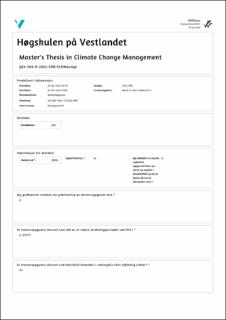| dc.description.abstract | As a result of global climate change, glacial lakes are undergoing rapid changes and are becoming more dynamic, posing a risk of outburst floods for communities and infrastructures nearby (Shugar et al., 2020). With no doubt, mainland Europe’s largest glacier, Jostedalsbreen has already experienced 20 GLOF events, out of 147 in Norway, with 4-5 events in the last 2 decades (Andreassen, Nagy, Kjøllmoen, & Leigh, 2022; Nagy & Andreassen, 2019). NVE has been closely monitoring glacial lakes in Norway including Jostedalsbreen through satellite-based application www.xgeo.no and inventories of glacial lakes in certain years. This study, however, analyzes the time series of higher frequency data to study rapid drainage events, month-to-month (seasonal)/year-to-year (annual) variations, and trend in growth of glacial lakes around Jostedalsbreen both with and without history of GLOF events in recent years.
The approach of the study is to calculate the Normalized Difference Water Index (NDWI) of Sentinel 2 and PlanetScope imageries acquired from Copernicus Satellite Services and Planet Labs websites, use a threshold NDWI value to separate the water pixels from non-water pixels and manually digitize where necessary to obtain the lake area. A threshold NDWI value which best represents the area of lakes and reduces the need for digitization is obtained with reference to manually digitized high resolution ortho-imagery of same lakes in Jostedalsbreen.
The study found no significant evidence of rapid drainage events indicative of GLOF. However, lake L2 (Associated Glacier: Marabreen/Glacier ID: 2364/type: glacier-dammed) and L19 (Associated Glacier: Supphellebreen/Glacier ID – 2352/type: moraine-dammed) both with history of GLOF events were found to be significantly reduced in size within an interval of 1 to 2 months, but the intermediate imageries showed no evidence of rapid drainage. Further, percentage variation (SD) in normalized maximum annual surface area of lakes connected-to-glacier was significantly higher (p-value = 0.01) than for lakes not-connected-to-glacier. Among all lakes, lake L23 (Glacial ID: 2293/type: supraglacial) showed the highest variation in overall 6 years. Though not significant, lakes connected-to-glacier including moraine-dammed lakes showed an increasing trend in maximum annual surface area in 6 years.
In recent years in Western Norway, the temperature has risen even higher (Meteorological Institute Norway, 2021), causing the ablation process to accelerate, resulting in an increased surface area of lakes (meaning more water or a rise in water level). Simultaneously, the glacier is also calving which might be a trigger factor for outburst in lakes connected-to-glacier. In such a scenario, the risk of damage due to potential outburst might be higher than before. Therefore, the need for a regular monitoring of glacial lakes, especially for lakes with high potential of outburst, is a most in Jostedalsbreen region. | en_US |

